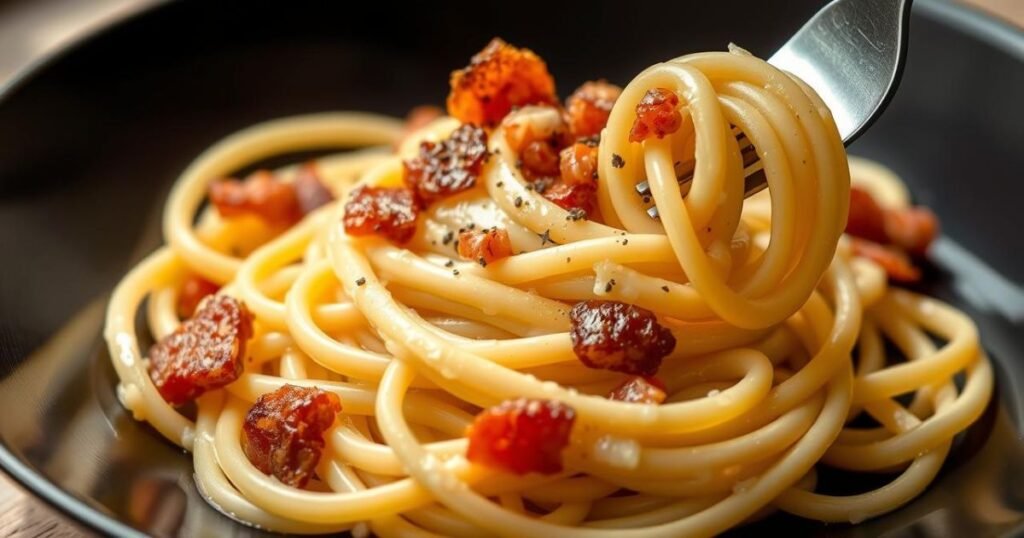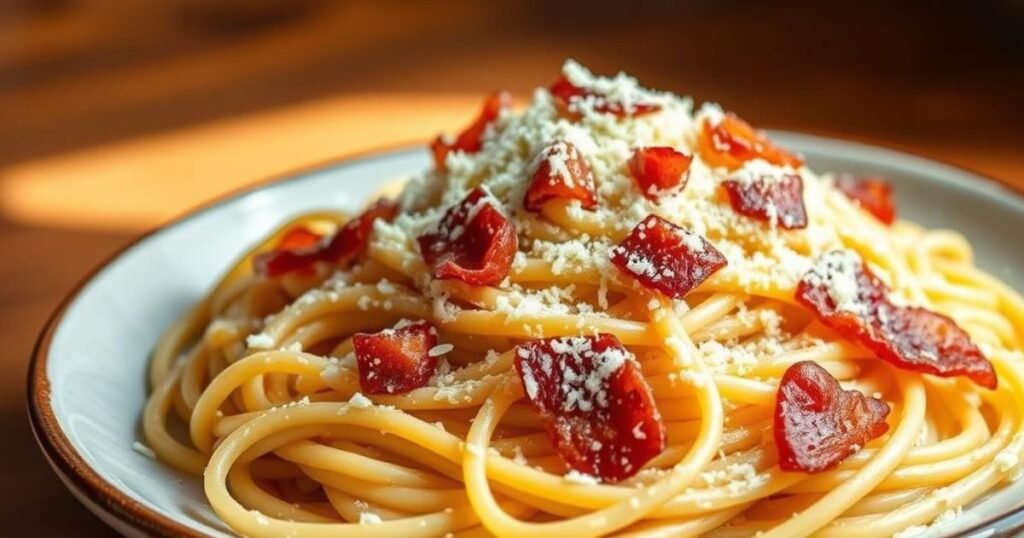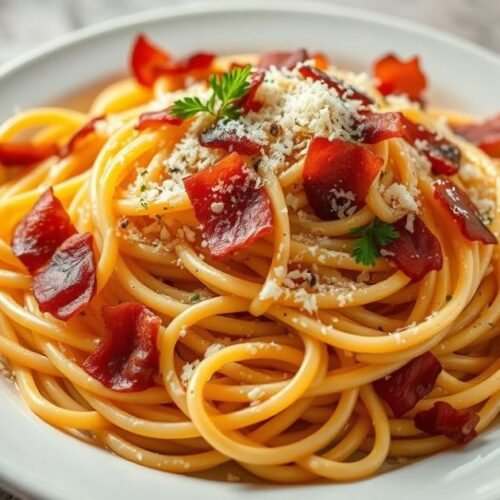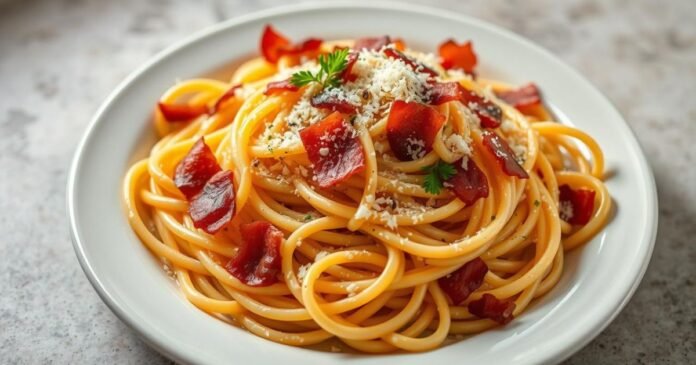I remember my first taste of authentic carbonara in a small Roman trattoria. The sauce was silky and rich, clinging to the spaghetti perfectly. It was a moment that started my love for this iconic dish. Now, I’m excited to share my easy carbonara recipe with you.
Many think carbonara is hard to make, but it’s actually quite simple. With a few quality ingredients and some basic techniques, you can make a creamy sauce just like the restaurants. Let’s start this tasty journey together and learn how to make perfect carbonara!
If you love pasta or just want to try something new, this guide is for you. We’ll cover the traditional ingredients, the egg-tempering trick, and how to get that smooth, creamy texture. This is what makes carbonara so special.
Get ready to wow your loved ones with this quick, easy, and delicious Italian dish. Let’s turn your kitchen into a little piece of Rome!
Authentic Italian Carbonara
Carbonara pasta is a beloved Italian dish loved by many. It’s a Roman classic made with simple ingredients. This creates a creamy, flavorful meal that’s great at any time.
Origin and History of Carbonara
Spaghetti alla carbonara started in Rome after World War II. Its exact origins are debated. Many think it was made by Italian charcoal workers or from American soldiers’ food mixing with local dishes. It quickly became a favorite in Roman trattorias.
Traditional vs Modern Variations
The traditional recipe uses just a few ingredients: pasta, eggs, Pecorino Romano cheese, guanciale, and black pepper. Modern versions might add garlic, onions, or peas. But, purists say these additions are not traditional.
Why Cream isn’t Traditional
Authentic carbonara doesn’t have cream. Its silky texture comes from eggs, cheese, and pasta water. Adding cream is a common mistake that weakens the dish’s rich flavors. True carbonara gets its creaminess from mixing egg sauce with hot pasta, without scrambling the eggs.
| Traditional Ingredients | Common Modern Additions |
|---|---|
| Pasta (usually spaghetti) | Cream |
| Eggs | Garlic |
| Pecorino Romano | Onions |
| Guanciale | Peas |
| Black Pepper | Parsley |
Essential Ingredients for the Perfect Carbonara Recipe
Making the perfect carbonara begins with choosing the right ingredients. Let’s look at the key parts that make this Italian dish stand out.
Choosing the Right Pasta
Spaghetti is the classic choice for carbonara. But, you can also use linguine or fettuccine. For the best texture and sauce hold, go for high-quality, bronze-cut pasta.
Guanciale vs Pancetta vs Bacon
Guanciale pork cheek is the authentic choice for carbonara. It has a rich flavor and lots of fat, making the sauce luxurious. If you can’t find guanciale, pancetta is a good substitute. For a bacon version, pick thick-cut, smoky bacon to get that guanciale taste.
The Importance of Fresh Eggs
Fresh, high-quality eggs are key for a silky carbonara texture. Use room temperature eggs to avoid the sauce from thickening when mixed with hot pasta.
Selecting Quality Cheese
Pecorino Romano cheese is the traditional choice for carbonara. It has a sharp, salty flavor that goes well with the rich pork. If Pecorino is hard to find, a well-aged Parmigiano-Reggiano is a good substitute.
| Ingredient | Traditional | Common Substitute |
|---|---|---|
| Pasta | Spaghetti | Linguine or Fettuccine |
| Pork | Guanciale | Pancetta or Bacon |
| Cheese | Pecorino Romano | Parmigiano-Reggiano |
| Eggs | Fresh, Room Temperature | N/A |
Kitchen Tools and Preparation Steps
Preparing to make carbonara is simple with the right tools. You’ll need a large pot for cooking your pasta. Fill it with water and heat it over high to boil.
For the sauce, a large skillet is essential. A 12-inch skillet is ideal for most recipes. Use it over medium heat to achieve a crispy texture without burning.
Here’s a quick list of other tools you’ll want handy:
- Tongs for handling pasta
- A whisk for mixing the egg sauce
- A grater for the cheese
- Measuring cups and spoons
Before cooking, measure out all your ingredients. This makes the process smoother and helps you avoid overcooking. With everything prepped and your tools ready, you’re set to create a delicious carbonara!
| Step | Tool | Heat Setting |
|---|---|---|
| Boil Pasta | Large Pot | High Heat |
| Cook Pork | Large Skillet | Medium Heat |
| Mix Sauce | Bowl | No Heat |
Mastering the Egg Sauce Technique
The egg sauce is the heart of any great carbonara. Let’s dive into the secrets of creating a silky smooth sauce. This will elevate your egg pasta recipe to new heights.
Temperature Control Tips
The key to a perfect carbonara lies in temperature control. Start by whisking raw eggs and egg yolks in a bowl. To prevent scrambling, temper the egg mixture by slowly adding a small amount of hot pasta water while whisking constantly.
Avoiding Scrambled Eggs
To keep your sauce smooth, remove the pan from heat before adding the egg mixture. The residual heat from the pasta will gently cook the eggs without scrambling them. Toss quickly and continuously to coat the pasta evenly with the egg sauce.
Creating the Perfect Silky Texture
For a luxuriously creamy texture, reserve some pasta cooking water. If your sauce is too thick, add a splash of this starchy water and toss to achieve the desired consistency. The result? A velvety carbonara that clings beautifully to your pasta.
| Ingredient | Amount | Purpose |
|---|---|---|
| Egg yolks | 2-3 per serving | Base for sauce |
| Pasta water | 1/4 cup | Adjust consistency |
| Guanciale fat | 1 tablespoon | Enhance flavor |
With these techniques, you’ll create a carbonara sauce that rivals any Italian restaurant. Remember, practice makes perfect, so don’t be discouraged if your first attempt isn’t flawless. Keep refining your skills, and soon you’ll be a carbonara master!

Step-by-Step Cooking Process
Let’s dive into the heart of making carbonara! This simple yet delicious dish comes together quickly when you follow these steps. We’ll start with cooking the pork, then move on to the pasta, and combine everything for a creamy, satisfying meal.
Cooking the Pork
Begin by cooking your chosen pork product. Whether you’re using guanciale, pancetta, or cooked bacon, the process is similar. Heat a skillet over medium-low heat and add your diced pork. Cook it slowly, stirring occasionally, until it turns golden brown and crispy. This should take about 10 minutes. Once done, set the crispy pork aside on a plate.
Preparing the Pasta
While the pork cooks, prepare your pasta. Fill a large pot with salted water and bring it to a boil. Add your spaghetti or chosen pasta and cook it until it’s just al dente. Before you drain the pasta, remember to reserve pasta water – about 1 cup should do. This starchy water is key for creating a silky sauce later.
Combining Ingredients
Now comes the exciting part! Drain the pasta and immediately add it to the skillet with the cooked pork. Toss everything together, adding about 1/4 cup of the reserved pasta water. The hot pasta will help melt the cheese and create a creamy sauce. Add your egg and cheese mixture, stirring quickly to coat the pasta evenly. If the sauce seems too thick, add more pasta water a little at a time until you reach the perfect consistency.
Remember, the key to perfect carbonara is timing and temperature control. Keep the heat low and work quickly to avoid scrambling the eggs. With practice, you’ll master this classic Italian dish in no time!
Common Mistakes to Avoid
Making the perfect creamy carbonara can be challenging. Many worry about getting scrambled eggs instead of a smooth sauce. Let’s look at common mistakes and how to steer clear of them when cooking this classic Italian dish.
One common mistake is adding too much heavy cream. An easy carbonara recipe with cream might sound good, but it’s not the real deal. The creaminess should come from the eggs and cheese.
Temperature is key. If your pan is too hot when adding the egg mix, you’ll get scrambled eggs. Take the pan off the heat before mixing the pasta with the egg sauce. The remaining heat will cook the eggs gently without scrambling them.
- Overcooking the pasta: Al dente pasta works best for carbonara
- Using pre-grated cheese: Freshly grated Pecorino Romano or Parmigiano-Reggiano is key
- Skimping on egg yolks: They’re essential for a rich, creamy texture
- Not reserving pasta water: It helps create the perfect sauce consistency
Remember, practice makes perfect. Even if your first try isn’t perfect, each attempt gets you closer to mastering this delicious creamy carbonara recipe. Keep these tips in mind, and you’ll soon be serving top-notch carbonara.
Serving and Presentation Tips
Now that you’ve got your carbonara recipe down, it’s time to serve it like a pro. The right presentation can make a big difference. Let’s look at some tips to make your carbonara stand out.
Proper Temperature
Serve your carbonara right away to keep it creamy. Warm your bowls before serving to stop the sauce from getting too thick. A warm plate helps keep the sauce just right.
Garnishing Options
Make your carbonara look good with simple garnishes. A sprinkle of freshly ground black pepper adds flavor and looks nice. For a bit of green, try chopped parsley or basil leaves. Remember, less is more with garnishes.

Conclusion
You’ve learned how to make authentic carbonara. This guide took you from its history to the best ingredients and techniques. The secret to great carbonara is in the egg sauce and using top-notch ingredients like guanciale or pancetta.
Don’t worry if your first try isn’t perfect. Making carbonara takes practice. As you get better, you might want to try variations like chicken carbonara or a Filipino style twist. The ingredients are simple, but the technique makes it special.
Carbonara tastes best when it’s fresh and hot, straight from the skillet. If you’re cooking for a few, you can halve the recipe in a medium skillet. No matter how you serve it, carbonara will become a favorite at home. So, get your pasta, eggs, and cheese ready and start cooking!
FAQ – Carbonara
What are the essential ingredients for an authentic carbonara?
For real carbonara, you need pasta (like spaghetti), eggs, and guanciale or pancetta. You also need Pecorino Romano cheese and black pepper. Remember, it doesn’t have cream.
Can I use bacon instead of guanciale in carbonara?
Yes, bacon works as a substitute for guanciale. It’s not the traditional choice, but it’s easy to find. Bacon will give a tasty result, but the taste will be a bit different.
How do I prevent the eggs from scrambling in carbonara?
To avoid scrambled eggs, temper them with hot pasta water while whisking. Then, mix the egg mixture with the pasta off the heat. The pasta’s heat will cook the eggs softly, making a creamy sauce.
Is it necessary to add cream to carbonara?
No, cream is not needed in traditional carbonara. The creamy texture comes from eggs, cheese, and pasta water. Adding cream can hide the dish’s true flavors.
What type of pasta is best for carbonara?
Spaghetti is the top choice for carbonara, but linguine or bucatini work too. Pick a long pasta that holds the sauce well.
Can I make carbonara ahead of time?
Carbonara is best served right after cooking. If left, the sauce can thicken and lose its creaminess. Cook the pork and cheese ahead, but mix everything just before serving.
What wine pairs well with carbonara?
A dry white wine like Frascati or Pinot Grigio goes well with carbonara. For red, a light Chianti can also pair nicely.
How can I make carbonara healthier?
To make carbonara healthier, use whole wheat pasta and less pork. Adding veggies like peas or asparagus can also help. But, these changes will change the dish’s taste and texture.
What’s the best way to reheat leftover carbonara?
Reheating carbonara can be tricky. The best way is to gently heat it in a pan with a splash of water or milk. Stir often and avoid overheating.
Can I make a vegetarian version of carbonara?
Yes, you can make a vegetarian version by skipping the pork. Use mushrooms or smoked tofu for flavor. Vegetarian cheese can also work, but it will change the dish’s taste a lot.

Easy Carbonara Recipe
Ingredients
- Spaghetti or linguine/fettuccine as substitutes
- Guanciale or pancetta or thick-cut bacon
- Fresh eggs 2–3 egg yolks per serving, room temperature
- Pecorino Romano cheese or Parmigiano-Reggiano as substitute
- Freshly ground black pepper
- Reserved pasta water about 1/4 cup
Instructions
- Cook the Pork
- Heat a skillet over medium-low heat. Add diced guanciale or other pork and cook slowly until golden and crispy (about 10 minutes). Set aside.
- Boil the Pasta
- In a large pot, boil salted water. Add pasta and cook until al dente. Reserve 1 cup of pasta water, then drain pasta.
- Make the Egg Sauce
- In a bowl, whisk 2–3 egg yolks per serving. Slowly temper the eggs by adding a bit of hot pasta water while whisking constantly to prevent scrambling.
- Combine and Finish
- Add hot pasta to the skillet with pork. Toss with about 1/4 cup reserved pasta water. Remove from heat. Quickly add the egg and cheese mixture, stirring continuously until creamy. Add more pasta water if needed for consistency.
- Serve Immediately
- Serve hot in warmed bowls. Garnish with black pepper and optionally parsley.
Notes
- Pasta Options: Use spaghetti for authenticity, or linguine/fettuccine for variety.
- Cheese Tips: Always use freshly grated cheese for best results.
- Egg Handling: Always temper eggs to avoid scrambling.
- Substitutes: Guanciale is ideal, but pancetta or bacon works well.
- Pasta Water: Essential for sauce consistency — never skip it.
- No Cream Needed: Authentic carbonara gets its creaminess from eggs and cheese only.
- Serve Fresh: Carbonara tastes best immediately after cooking.
- Wine Pairing: Pinot Grigio, Chianti, or Prosecco pair well.
- Reheating: Use a splash of water or milk over low heat, stirring constantly.
- Vegetarian Option: Use mushrooms or smoked tofu instead of meat, but flavor will vary.

